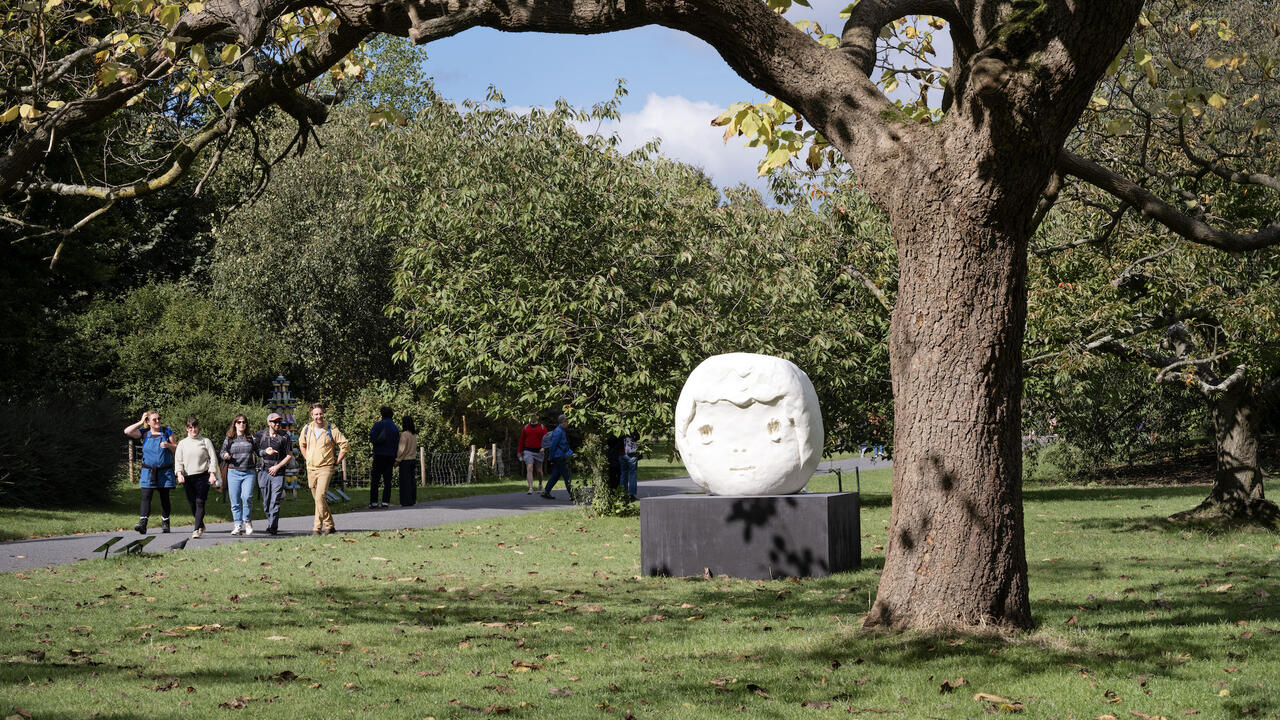Raffi Kalenderian
Galerie Peter Kilchmann, Zurich, Switzerland
Galerie Peter Kilchmann, Zurich, Switzerland

A hairy man in leaf-patterned shorts sits on a yellow chair in front of a garden wall. In the background looms a thick green tangle of plants. A little way off, a barefooted woman also sits on a chair, one hand in her lap. She looks over at him. He looks at a dog that strikes a fighting pose on the lawn. Each seems to be waiting for the other to make a move. These two individuals and their pet are introduced to us in the title of this work as Shio, Jonas, Robot (Outside) (2008).
In recent years, as well as paintings on canvas, Raffi Kalenderian has produced a series of works on paper using watercolours, graphite and coloured pencils, sometimes combined in collages with found photocopied material. Most of Kalenderian’s protagonists are depicted in full-length portraits in domestic settings, the works’ titles giving us their first names only. In shimmering colours, attractively decorated private rooms and lush front gardens offer glimpses of household interiors or studios. But the works in this exhibition, titled ‘Satellites’, never offer a wider view to the horizon or out into a cityscape. Instead, Kalenderian’s backgrounds present an almost claustrophobic closure. This is due primarily to a simple visual trick that reinforces a ‘faulty’ perspective: at times, things our perception would register as being further away are shown at the same scale as motifs in the foreground. As a result, background spaces are reduced to a two-dimensional ‘curtain’ and the figures appear as though placed in front of sumptuous drapery or stock backdrop in a portrait studio. Most of these backdrops are fully developed, but some are merely sketched out in neon colours.
The flat, ornamental character of the backgrounds accentuates a certain indifference in the demeanour of those portrayed. Their gaze is often averted from their potential audience – with the notable exception of Self-Portrait Arroyo Seco (2008), where the eyes of the young, bearded artist in casual clothes directly meet those of the viewer. With Kalenderian’s figures, the chronically psychologized genre of the portrait and its relationship to the audience are subjected to scrutiny. In spite of the works’ intimate settings and the personal details they reveal, the protagonists in their fashionable clothes appear almost homogeneous, detached from any individual temporal specificity. With their air of waiting for something, however, these people also point to a different narrative that could take place beyond the temporal and spatial limits of the picture frame. In that respect, the subjects’ poses are reminiscent of 1990s’ posed photography: the arranged setting, the vacant stare while waiting for the camera’s shutter to click. British artist Sarah Jones, for example, placed her adolescent models in luxuriously decorated living rooms or front gardens. Kalenderian, on the other hand, portrays a young society in leisurewear, waiting for something and killing time with books and art. In the fittingly restrained formats of drawing and painting, Kalenderian makes a striking commentary on the self-centred confinement of today’s ‘leisure class’.
Translated by Nicholas Grindell.























